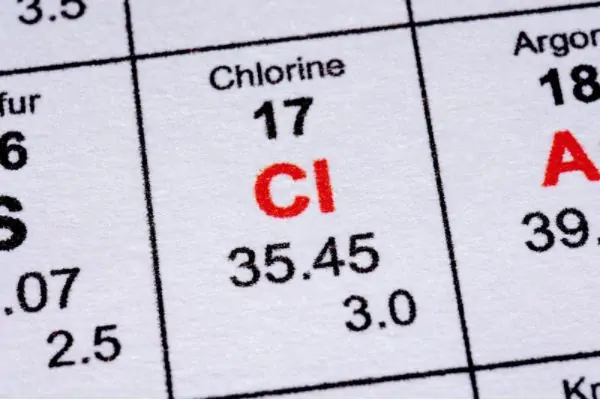Both pool and hot tub owners refer to three types of chlorine to look out for – total chlorine, free chlorine and combined chlorine. I will go into the differences between free chlorine vs total chlorine vs combined chlorine below.
Free chlorine refers to the amount of chlorine that is available to actively sanitize the water in a pool or hot tub whereas total chlorine refers to the sum of the free chlorine and chlorine that has already been used during the sanitization process (known as combined chlorine).
In this post, you will learn the difference between the three types of chlorine and what to do depending on the proportions of each type of chlorine that exists.


What is free chlorine?
Free chlorine is the amount of chlorine that is available in the pool water to deal with microbes and bacteria and any other contaminants that may be present.
When it does tackle the contaminants it “combines” with them so then becomes combined chlorine and unavailable to sanitize any further.
What is combined chlorine?
Once the free chlorine does its work and sanitizes, by combining with contaminants in the water, it then becomes combined chlorine and is no longer available to further sanitize the water.
Combined chlorine is also known as Chloramine.
When the amount of combined chlorine in swimming pool water becomes high is when you may experience that swimming pool smell that many people associate with chlorine. This can happen when the combined chlorine levels exceed 0.5 ppm (parts per million). This is a good indication that you need to shock your pool.
What is total chlorine?
Total chlorine is the amount of free chlorine plus the combined chlorine added together.
Total chlorine = free chlorine + combined chlorine
Total chlorine being the same as free chlorine is a good thing, whereas combined chlorine and total chlorine being the same is not. I will explain this further in the post.

How to test for free, combined and total chlorine
It is important to test the quality of your pool water regularly, particularly to ensure that the chlorine levels are correct. Basically, there are four different ways of testing your pool water.
Pool store testing service
Many pool stores offer a free pool water testing service using an electronic water analyzer (some make a small charge for this). Unless your nearest pool store is just down the street then doing this frequently is not convenient.
Don’t forget that the reason they do this free of charge is that they want to sell you lots of pool chemicals to correct any readings which are not correct.
So by far the best way of testing the chlorine levels in your pool (and checking all other aspects of your water quality is to test it at home using one of the available test kits. The pool store will be happy to sell you one of these too.
Home testing using a test kit
There are three ways of testing the levels of chlorine in your pool at home.
Doing it yourself will not only make you feel a bit like a chemist but it will also:
- allow you to test more frequently
- enable to you to make smaller changes to maintain the water quality since you can be testing more often
- give you a better understanding of the needs of your pool
- probably save you money in the long term since most pool stores actually only test your water for you to give them the opportunity to sell you more chemicals
Liquid test kits
These are probably the most complicated of the three methods but do give good results. They involve filling a two-part container with pool water and then adding various reagents to it which change color to give readings for free chlorine, bromine, pH, acid demand and total alkalinity.
The most popular pool and spa water test kit is the Poolmaster Pool and Spa Essential Collection Chemistry Case which comes as a starter kit, including a supply of reactive solutions plus you can buy additional solutions when you run low.
Test strips
Test strips are without a doubt the most popular method as they are both cheap and quick to use.
You just take a test strip and plunge it in the water for around 20 seconds to give the reagents on the strip time to react and change color. Then you check the readings (shown as different colors) against the scale on the side of the container.
Some are available which only show a few readings for free chlorine, pH and total alkalinity. Others show multiple readings for total hardness, total chlorine, free chlorine, bromine, total alkalinity, cyanuric acid and pH. They don’t usually show the combined chlorine as you can easily work this out by subtracting the free chlorine from the total chlorine.
I use JNW Direct Pool and Spa Test Strips which show all of these readings and are very economical to use.
Electronic test kits
The most popular of these is the Aquachek Trutest Digital Reader. You still have to buy the special test strips which you plunge into the pool water but you then insert them in the machine which analyzes them and gives a digital readout. These are particularly useful for anyone who is color blind as with the methods above you need to be able to distinguish between different colors and shades.
What should the chlorine levels be?
Using the above methods to test the chlorine in your water you should try to get the levels of chlorine as follows:
- Free chlorine. Should be in the range of 1 to 5 parts per million (ppm) with an ideal range of between 2 and 4 ppm
- Combined chlorine. Should have a reading of less than 0.5 ppm and ideally significantly less.
- Total chlorine. In an ideal world this level should be the same as the free chlorine, or very close.
If your free chlorine levels are too high then are ways to reduce them. Read my post How to reduce chlorine levels in a pool for more details.
FAQs
Should total chlorine and free chlorine be the same?
Although free chlorine and total chlorine levels do not have to be exactly the same, if your pool water reading shows that they are both identical then that is a good thing. If both are the same this means that there is no combined chlorine so the water must be completely free of contaminants so it is fully sanitized.
Should total chlorine be higher than free chlorine?
Since total chlorine is the free chlorine and combined chlorine in your pool water added together then your total chlorine level must always be higher than, or at least equal to, the free chlorine in the water. The free chlorine level can never be higher than the total chlorine level as, if you added more free chlorine, then the combined chlorine level would rise by the same proportion.
Why is my total chlorine high but free chlorine low?
When you test your pool water, if your total chlorine levels are high but the amount of free chlorine is shown as being low, then this is an indication that the amount of combined chlorine must be high. You will probably also have that familiar chlorine swimming bath smell which all indicates the presence of chloramines, ie. the combination of free chlorine combined with contaminants that have locked together to form combined chlorine. If your combined chlorine and total chlorine are the same then it means you have no free chlorine left so your pool will not be sanitized. If this is the case then you will need to add chlorine by giving your pool water a shock treatment.
How do I raise the free chlorine in my pool?
You should raise the free chlorine level in your pool by giving it a good shock treatment. The same is true for raising the free chlorine in a hot tub.









Leave a Reply